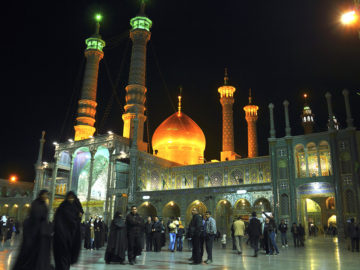Qom province with an area of 11,526 square kilometers ranks the 30th largest province of Iran. Surrounding by Tehran, Isfahan, Markazi, and Semnan provinces, and the Salt Lake, the center of the province is Qom city. Interestingly, it is the only province of the country which has only one city i.e. Qom.
Various ethnic groups with their own language including Persians, Turks, and Arabs reside in Qom. The northern slopes of the Zagros Mountains including Mount Palang Abi as the highest point cover the southern part of the province. In terms of climate, because of various altitudes, the temperature varies in different areas of the province.

The oldest historical evidence found in Qarah Tappeh in the Qom Roud area, Qom province belongs to the past sixth to the fourth millennium. Also, during and after the Achaemenid Empire (550-330 B.C.), the name of Qom has been documented several times. Particularly after the advent of Islam in 651 A.D., due to the presence of the holy shrine of Fatima Masumeh, the importance of the city was intensified. However, its historic incidents and events mostly have happened in the surrounding areas including Ray and Kashan rather than the city of Qom.
After the Mongol invasion in 1206, a feudal system was run in most parts of Iran but following the formation of the Shiite Safavid government (1501-1736), the land of Qom found a special position. For example, many monuments inside and around Qom were built. During the Constitutional Revolution, a large group of scholars and clerics from Tehran migrated to Qom in order to protest against the Muzafar al-Din Shah’s (reign: 1896-1907) hesitation in signing the Constitutional Law but finally, they returned to Tehran when the decree was signed.
The Holy Shrine of Fatima Masumeh is the second most important religious shrine in Iran, making Qom the main pilgrimage center following Mashhad city because of the shrine of Imam Reza. This, along with other religious places such as tombs, shrines, caravanserais, and mosques, especially Jamkaran Mosque, has turned the city mainly into a religious destination for domestic ad inbound pilgrims.
The primary local handicrafts of Qom include silk carpets, wood carving, tiles, ceramics, Mohr (a clay-made object on which Shiite Muslims prostrate when praying), prayer mat, and Aba (cloak), precious stones, and stone carving.
Undoubtedly, one of the most famous souvenirs and exports of Qom is Sohan (a kind of sweet), while other local souvenirs are walnuts, dried apricots, hazelnuts, pomegranates, and figs. Also, of the native foods, we mention Kalle Joosh (a special type of soup), Qunabid (meat stew), Aush (a kind of stew with different beans), Halim, traditional bread, sesame extract, sesame Halva.

